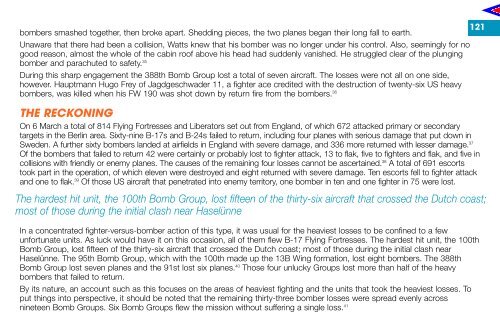THE RAF AIR POWER REVIEW - Royal Air Force Centre for Air ...
THE RAF AIR POWER REVIEW - Royal Air Force Centre for Air ...
THE RAF AIR POWER REVIEW - Royal Air Force Centre for Air ...
You also want an ePaper? Increase the reach of your titles
YUMPU automatically turns print PDFs into web optimized ePapers that Google loves.
121<br />
bombers smashed together, then broke apart. Shedding pieces, the two planes began their long fall to earth.<br />
Unaware that there had been a collision, Watts knew that his bomber was no longer under his control. Also, seemingly <strong>for</strong> no<br />
good reason, almost the whole of the cabin roof above his head had suddenly vanished. He struggled clear of the plunging<br />
bomber and parachuted to safety. 35<br />
During this sharp engagement the 388th Bomb Group lost a total of seven aircraft. The losses were not all on one side,<br />
however. Hauptmann Hugo Frey of Jagdgeschwader 11, a fighter ace credited with the destruction of twenty-six US heavy<br />
bombers, was killed when his FW 190 was shot down by return fire from the bombers. 36<br />
<strong>THE</strong> RECKONING<br />
On 6 March a total of 814 Flying Fortresses and Liberators set out from England, of which 672 attacked primary or secondary<br />
targets in the Berlin area. Sixty-nine B-17s and B-24s failed to return, including four planes with serious damage that put down in<br />
Sweden. A further sixty bombers landed at airfields in England with severe damage, and 336 more returned with lesser damage. 37<br />
Of the bombers that failed to return 42 were certainly or probably lost to fighter attack, 13 to flak, five to fighters and flak, and five in<br />
collisions with friendly or enemy planes. The causes of the remaining four losses cannot be ascertained. 38 A total of 691 escorts<br />
took part in the operation, of which eleven were destroyed and eight returned with severe damage. Ten escorts fell to fighter attack<br />
and one to flak. 39 Of those US aircraft that penetrated into enemy territory, one bomber in ten and one fighter in 75 were lost.<br />
The hardest hit unit, the 100th Bomb Group, lost fifteen of the thirty-six aircraft that crossed the Dutch coast;<br />
most of those during the initial clash near Haselünne<br />
In a concentrated fighter-versus-bomber action of this type, it was usual <strong>for</strong> the heaviest losses to be confined to a few<br />
un<strong>for</strong>tunate units. As luck would have it on this occasion, all of them flew B-17 Flying Fortresses. The hardest hit unit, the 100th<br />
Bomb Group, lost fifteen of the thirty-six aircraft that crossed the Dutch coast; most of those during the initial clash near<br />
Haselünne. The 95th Bomb Group, which with the 100th made up the 13B Wing <strong>for</strong>mation, lost eight bombers. The 388th<br />
Bomb Group lost seven planes and the 91st lost six planes. 40 Those four unlucky Groups lost more than half of the heavy<br />
bombers that failed to return.<br />
By its nature, an account such as this focuses on the areas of heaviest fighting and the units that took the heaviest losses. To<br />
put things into perspective, it should be noted that the remaining thirty-three bomber losses were spread evenly across<br />
nineteen Bomb Groups. Six Bomb Groups flew the mission without suffering a single loss. 41

















